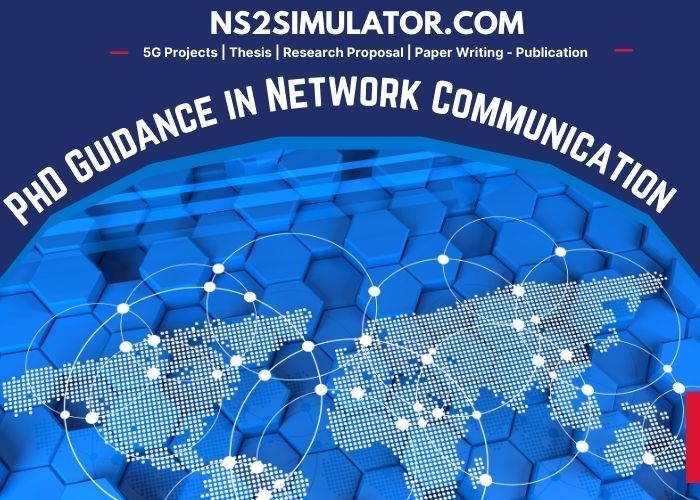Network communication is also termed internetworking which enables the application programs to interact autonomously with their physical networks. It allows application programs to communicate with each and every one regardless of hardware and operating systems. On this page, we would like to share some significant information on recent research growth with our PhD guidance in Network Communication!!!
What are the components of Network Communication?
There are mainly five components of a data communication system:
- Communication Message
- Sender (Source)
- Receiver (Destination)
- Medium of Transmission
- Protocol (Set of rules)
What is the next big thing in Network Communication?
Nowadays, intent-based networking has gradually attained the position of “next big thing” in networking. Primarily, it builds on artificial intelligence and machine learning to appoint and perform various activities, For instance, routine tasks, set of rules; respond to system events, etc. IBN is an expected successor to SDN which inherits the same principles and designs. Also, it specifies the gap between the application and the network structure.
Moreover, it implicitly has the potential to advance the way it monitors and responds to network events and conditions. Like SDN, IBN is creating software that controls the whole network rather than device-to-device.
For your reference, we have listed out few important belongings of Intent-based networking system,
- Translation and Validation – In a system, the end-users distribute the higher-level research plan (what) and translate it to the needed network configuration (how). Then the generated outcomes of design and configuration are authorized for the correctness
- Automated Implementation – Here, the system can organize the suitable network variations (how) through the present network structure. Whereas, this is achieved through network automation and orchestration
- Awareness of Network State – The system devours position of the real-time network in administrative control and protocol- and transport-agnostic
- Assurance and Dynamic Optimization/Remediation – Here in real-time, the system constantly authenticates whether the objective is encountered or not. If not, then it takes effective corrective actions such as follows,
- Blocking Traffic
- Modifying Capacity of Network
- Notifying Network
What are some of the key features of an intent-based network?
- Speed and Agility – The network response rises with the guiding principle of ‘what to attain’ more willing than ‘how to attain.
- Reduced Risk – Advanced visibility of network, enriched analytics, and trained model to automate and enhance threat detection and reduce the downtime of network
So far, we have discussed the future direction of network communication. Our PhD Guidance in Network Communication platform is furnished with numerous unbelievable research ideas. Now, let’s see different research perceptions of network communication.
Research Challenges in Network Communication
A particular degree of action in an application is assured by the QoS. Whereas, it signifies the competence and control of applications such as safety and data flow traffic. Majorly, QoS is employed to attain a short average delay time and minimum packet loss. Voice through IP traffic can achieve using promising the error, bandwidth, and jitter.
The quite crucial data communications challenge in mobile/wireless/wired networks has always been transmitting large data in lesser time. For the most part, to acquire the objective, it increases the following factors,
- Band rate or Bits per second
- The total capacity of the World Wide Web
- Coverage area across the world by length and breadth
In addition, our experts have itemized other significant research ideas that we are currently working on.
Research Ideas in Network Communication
- Traffic Congestion
- Redundancy of Data Prediction
- Traffic Information Variation
- Increasing Transmission Delay Measurements
- Quick Response in Emergency Events
- Traffic Flow Control in Huge Network Density
To achieve the above-specified breakthroughs, both research and data analysts communities have proposed a few research areas in which the future wireless systems utilize several developing technologies. And, some of them are as follows,
Network Communication Research Areas
- Wireless Sensor Networks (WSN)
- Coordinated Multipoint Operation (CoMP)
- Mobile Ad Hoc Networks (MANETs)
- Millimeter-Wave (mm-wave) Technology
- Cognitive Radio Networks
- Device-to-Device (D2D) Communication
- Heterogeneous Networks (HetNet)
- Cellular Cloud Computing and Big Data
- Ethernet Passive Optical Networks (EPON)
- Internet of Things (IoT)
- Cooperative Networks (CR) with Relay Nodes (RNs)
- Massive-Multiple Input Multiple Output (M-MIMO)
For your information, our technical professionals have given you some foremost research ideas for getting PhD Guidance in Network Communication.
Research Topics in Network Communication
- Modern communication protocols design: provides higher frequency in terms of Giga Range with newer electromagnetic waves variants to attain rapid communications over the air
- Effective high-speed data transmission using data compression and error correction techniques
- Advanced distribution mechanisms such as drones, air-balloons or unmanned aerial vehicles in the stratospheric region to support a broader coverage
By the by, if you want flawless PhD Guidance in Network Communication then you can connect with us. Our research team provides you complete research service for your study.

